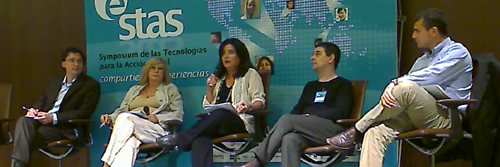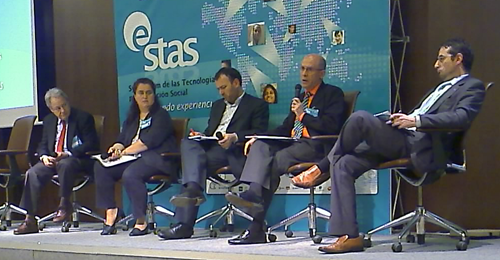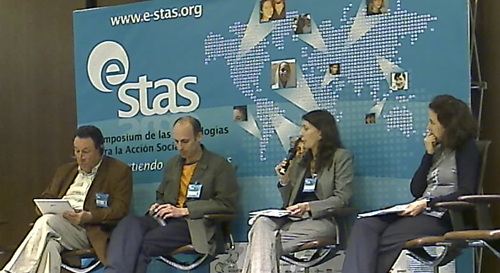By Ismael Peña-López (@ictlogist), 26 April 2008
Main categories: Development, ICT4D, Meetings, Participation, Engagement, Use, Activism
Other tags: e-stas, e-stas2008
No Comments »
e-STAS is a Symposium about the Technologies for the Social Action, with an international and multi-stakeholder nature, where all the agents implicated in the development and implementation of the ICT (NGO’s, Local authorities, Universities, Companies and Media) are appointed in an aim to promote, foster and adapt the use of the ICT for the social action.
Last reflections
It’s a pity that I couldn’t take notes on the last session of the event, where conclusions from the different round tables and workshops where read: I was on the stage and just had not the chance to type.
Summing up now is way too difficult. I can just say that this is one of the events you cannot miss, especially because “everyone” is there and the people you meet, their reflections, their insights, etc. are richest for your own knowledge development.
But there is a growing feeling that I have regarding how people look at ICTs. On one hand, there is more and more the consensus that users do have to be taken into account in the design of the projects, tools, initiatives, programs, etc. that are addressed to them. Whatever their origin. If it ever made sense, now it’s pretty clear for almost everyone that governments have to listen to the citizenship to build e-government, e-administration or e-democracy initiatives; that nonprofits do have to have the participation of their beneficiaries (and all other stakeholders such as volunteers) when spending their budgets in whatever; even that firms need to listen to the customer and the society at large and put them in the equation when engaging in any sort of project.
On the other hand, I worry about the ironically appearance of a new tier of actors in this ICT-adoption game. Thus, the usual donor-receiver or expert-beneficiary scheme has been altered this way:
- Late adopters: the ones that do not use and/or do not know about ICTs and their application
- Heavy adopters: the ones that use them intensively and try to replicate their own path elsewhere
- Digerati: the ones that are aware (or think so) of the potential benefits and costs of ICTs, and deeply reflect and think about the implications of ICT use and the impact of the Information Society in development and life in general
Surprisingly, heavy adopters and digerati — formerly the same thing — are not necessarily the same people. I’m progressively seeing heavy adopters that simply can not put themselves in the place of others or are not aware of the implications of what they are doing (teens vs. social networks, privacy or intellectual property rights is often put as a good example of this; developed countries’ users vs. developing countries’ potential users is another one). And, indeed, there is a growing plethora of digerati that can provide theoretical grounded evidence and advice but are not heavy users and, sometimes, not even users at all (yes, scholars and blogging is a pretty clear example; international development agencies vs. developing countries another one).
The problem is that they both need each other: heavy adopters need to take their time to think, “thinkers” can’t think of what they do not know by heart. And they all need to engage in the conversation with the goal of their thoughts and actions. Which leads me to the next question.
On access as a dependent variable
Dani Matielo asked on a comment about Raul Zambrano’s statement that we had to take access as a dependent variable and no longer as an independent one.
The rationale behind is the following: even if there still is a lot of work to do to provide access to billions of people, two aspects seem to have more relevance:
- Access for the sake of it has proved to be completely wrong. Only purpose-driven access (for what services, for what content) can succeed, so we need to first define what for, and then design how.
- But how access takes place (e.g. with a desktop, with a mobile phone) will also determine and be determined by the uses, the services… and the overall development of an Information Society
This is why access is no more an exogenous thing, an independent variable of the equation, but just a variable that depends on the addition of other ones (culture, the economy, labor, democracy, etc.) that define what the goal really should be: the development of the Information Society depending on each one’s framework.
e-Stas 2008, Symposium on Technologies for Social Action (2008)
By Ismael Peña-López (@ictlogist), 26 April 2008
Main categories: ICT4D, Meetings, Participation, Engagement, Use, Activism
Other tags: e-stas, e-stas2008
No Comments »
e-STAS is a Symposium about the Technologies for the Social Action, with an international and multi-stakeholder nature, where all the agents implicated in the development and implementation of the ICT (NGO’s, Local authorities, Universities, Companies and Media) are appointed in an aim to promote, foster and adapt the use of the ICT for the social action.
Here come my notes for session VII (notes at random, grouped by speaker, but not necessarily in chronological order)
 Left to right: Fabio Nascimbeni, Susana Finquelievich, Georgina Cisquella (moderator), Enrique Varela, Julio Andrade
Left to right: Fabio Nascimbeni, Susana Finquelievich, Georgina Cisquella (moderator), Enrique Varela, Julio Andrade
Susana Finquelieveich, Links
There’s always been social networks. But now, thanks to the Internet, they can have a wider reach.
It’s important that sponsors and international agencies understand the usefulness of social networks and support them, both politically and economically.
Fabio Nascimbeni, Vit@lis
Some social networks have been born on the Internet. They are not “bone and flesh” networks gone digital, but digitally born.
The network is making possible that things that wouldn’t happen can actually take place, or that people that would never meet can now work together.
Networks have to be independent from the financial sources and political pressures.
Social networks have enabled conversations between different actors with different roles, e.g. nonprofits and sponsors.
We don’t have to think around technologies, but what is the problem we are facing and how should the solution look like.
Partnerships between nonprofits and firms are difficult and hard to manage, but the results are usually great if the institutions succeed at weaving the network.
Local administrations do need to use (digital) social networks to interact with the civil society, learn from each other, work together, etc.
e-Stas 2008, Symposium on Technologies for Social Action (2008)
By Ismael Peña-López (@ictlogist), 26 April 2008
Main categories: Digital Divide, ICT4D, Meetings, Nonprofits, Participation, Engagement, Use, Activism
Other tags: e-stas, e-stas2008
No Comments »
e-STAS is a Symposium about the Technologies for the Social Action, with an international and multi-stakeholder nature, where all the agents implicated in the development and implementation of the ICT (NGO’s, Local authorities, Universities, Companies and Media) are appointed in an aim to promote, foster and adapt the use of the ICT for the social action.
Here come my notes for session VI.
Ángel de la Riva
Cibervoluntarios
CiberMix: Diffusion and advocacy program that shows the benefits of ICTs in institutions, firms and citizens in rural areas through educational, leisure, content and services activities.
periodismociudadano.com: a gate for initiatives, experiences, people, etc. that deal with citizen journalism.
The goals of citizen journalism (and blogging): listen, link, impact, share.
Digital World Forum on Accessible and Inclusive ICT
.
Low cost computing has revolutionized access to ICTs. Now the project wants to analyze where technology is heading.
The problem of low cost computers is data storage, but if Internet access is cheap too (i.e. thanks to cheap wireless networks), the data can be stored online.
infopreneur: the telecenter at the minimum expression, developed by the Meraka Foundation.
Emprendedores sociales, Ashoka‘s branch in Spain to foster social entrepreneurship.
Carlos Flores
socialGNU, to foster the diffusion and use of free software in nonprofits.
Alejandro Simon
Zoowa, to create and share your agenda 2.0.
e-Stas 2008, Symposium on Technologies for Social Action (2008)
By Ismael Peña-López (@ictlogist), 24 April 2008
Main categories: ICT4D, Meetings, Nonprofits, Participation, Engagement, Use, Activism
Other tags: e-stas, e-stas2008
1 Comment »
e-STAS is a Symposium about the Technologies for the Social Action, with an international and multi-stakeholder nature, where all the agents implicated in the development and implementation of the ICT (NGO’s, Local authorities, Universities, Companies and Media) are appointed in an aim to promote, foster and adapt the use of the ICT for the social action.
Here come my notes for session V.
Subjects
- Free software
- Accessibility and usability
- Linguistic diversity
- Educational programmes
- New content programmes
Debate
(random ideas, slightly sorted/grouped)
Muhammad Yunus proposes a new kind of enterprise where the focus is on stakeholders and not on shareholders, where no profit is seek, but only social benefit.
Low cost computers/devices are converging with mainstream infrastructures. Now the issue is content. There is no content for education, and this should be urgently addressed. And this content should be localized, as long as it’s happening with software (sometimes).
Nonprofits and firms could provide this content.
But can this content can be created in the same ways as free software?
People should bet on free software (not open source software), with a focus on the philosophy of free software: new ethics of work, money and network.
Knowledge should be free and is the Humanity’s patrimony. No one should own knowledge (and this includes software). Content is just the support (and can hence be owned), and each society will generate its own. Technology (= applied knowledge) should be free so it can be appropriated by individuals and communities.
If software is free, usability and accessibility come naturally, as long as linguistic diversity. Let aside costs.
Hardware, software, content, etc. should be measured by their social value, not their price, thus leading to a new ethics of value. The Digital Divide is created by the market, so the market should be taken into the spotlight when trying to bridge the Digital Divide.
The citizenry should be literate enough to be able to distinguish between different software and different content. To be aware of the implications, needs, threats, benefits of the Information Society.
Accessibility is not only being able to access ICTs/the Internet, but willing to and be aware of the costs and benefits of doing it.
Education is a very important issue, but who trains the trainers? Shouldn’t be the digital literacy trainers be more literate in e.g. technology neutrality and teach skills/competences and not specific applications?
Training should be appealing to the end user (e.g. stress in their short run needs), but also a door to further skills achieving. And these skills should include higher levels of thought where the individual can not only use some technologies, but be able to choose among several ones, reflect on their process of choice, etc.
e-Stas 2008, Symposium on Technologies for Social Action (2008)
By Ismael Peña-López (@ictlogist), 24 April 2008
Main categories: Cyberlaw, governance, rights, Digital Literacy, Education & e-Learning, ICT4D, Knowledge Management, Meetings, Open Access, Participation, Engagement, Use, Activism
Other tags: e-stas, e-stas2008
No Comments »
e-STAS is a Symposium about the Technologies for the Social Action, with an international and multi-stakeholder nature, where all the agents implicated in the development and implementation of the ICT (NGO’s, Local authorities, Universities, Companies and Media) are appointed in an aim to promote, foster and adapt the use of the ICT for the social action.
Here come my notes for session IV. (notes at random, grouped by speaker, but not necessarily in chronological order)
 Left to right: Francisco Ortiz Chaparro, Belén Perales, Javier Estévez (moderator), Javier de la Nava Trinidad, José Manuel García Prieto
Left to right: Francisco Ortiz Chaparro, Belén Perales, Javier Estévez (moderator), Javier de la Nava Trinidad, José Manuel García Prieto
Belén Perales, IBM
Why corporate volunteering? Employees demand it and their satisfaction, engagement, etc. does increase with nonprofit or development projects engagement. And this does benefit the firms beyond profit.
Francisco Ortiz Chaparro, AHCIET
Public-private partnerships are an important key for the development of the Information Society.
Big firms are kidnapped by their highest directors, that apply for themselves retribution policies that generate huge inequalities within the firm. This is a barrier for both the credibility of the firm as socially committed and the engagement of the rest (the basis) of the employees. Shareholders should enforce their rights to achieve more transparency and accountability of the behavior of such boards of directors, for both economic management and social responsibility reasons.
There is a good amount of nonprofits and projects that are created ad hoc as (public) grant raisers. Nonprofits should change their minds and think on project designs that could include firms and even benefit them, so through a mutual benefit, partnerships between the civil society and enterprises could arise. And, at the same time, the project will gain sustainability.
Javier de la Nava Trinidad, BBVA
The five groups of stakeholders: shareholders, providers, customers, employees, the society at large. And it is not only the customers that a firm has to keep content, but the whole panoply of stakeholders.
There is an increasing need for employers to have their employees engaged and identified with the firm, to be satisfied in their workplaces.
It’s true that telecoms benefit from more ICT use, hence why fostering its use in their corporate strategy.
There is not a single model of cooperation between nonprofits and firms, but normally the model is that firms give away the know how, their knowledge, their human capital, etc.
e-Stas 2008, Symposium on Technologies for Social Action (2008)
By Ismael Peña-López (@ictlogist), 24 April 2008
Main categories: Digital Divide, Digital Literacy, ICT4D, Meetings, Nonprofits, Participation, Engagement, Use, Activism
Other tags: e-stas, e-stas2008
No Comments »
e-STAS is a Symposium about the Technologies for the Social Action, with an international and multi-stakeholder nature, where all the agents implicated in the development and implementation of the ICT (NGO’s, Local authorities, Universities, Companies and Media) are appointed in an aim to promote, foster and adapt the use of the ICT for the social action.
Here come my notes for session III. (notes at random, grouped by speaker, but not necessarily in chronological order)
 Left to right: Raoul Weiler, Jérôme Combaz, María del Mar Negreiro, Berta Maure Rubio
Left to right: Raoul Weiler, Jérôme Combaz, María del Mar Negreiro, Berta Maure Rubio
It will be possible for everyone to access the Internet trough/thanks to low cost devices.
But education will make the difference, not devices.
Jérôme Combaz, Charte pour l’Inclusion Numérique et Sociale
Technology has to be transparent and should address social problems in a social way.
María del Mar Negreiro, European Union Lisbon Strategy
i2010 focuses on uses, digital literacy and how the Internet can help people connect each other, access better jobs, etc. To do so, focus on skills.
Teachers are using — the ones that do — the Internet to prepare their classes, get some materials, but they are not using ICTs when teaching or into the classroom. There still is a reluctance to do so, even if students seem pleased and more motivated when such a thing happens. Lack of skills, lack of time, lack of technical support are among the main reasons adduced by teachers to justify not being more pro-active fostering the use of ICTs when teaching.
Accessibility and usability as a goal to achieve more and better access to the Internet. And, thus, that people find Internet useful for their daily life.
e-Stas 2008, Symposium on Technologies for Social Action (2008)




